
|
Static Tests
Performed on the electronic test stands Year 2007 |

|
Static Tests
Performed on the electronic test stands Year 2007 |
| < Go to 2006 tests | Go to 2008 tests > |
| Excel File |
Thrust Curve |
Description |
Video |
||||||||||||||||||||||||
| 1-27-07A1 (click for spreadsheet) |
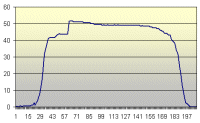 |
38-240 Casing, Dextrose rcandy
Evidence that KN/DX rcandy works and can be used in my motors. Burn time is longer than with recrystallized KN/Sucrose. |
Video 1 meg, 3 seconds .mpg file |
||||||||||||||||||||||||
| 2-24-07C (click for spreadsheet analysis) |
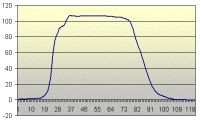
|
38-240 casing, Malt Extract/Dextrose propellant. Approximately 2:1 dextrose to malt extract, plus about 0.3% RIO
This made a sharp little burn, surprising, since the malt extract propellant would not burn at all unless a torch was held to it (see Video 0) and dextrose propellant burns more slowly than KN/sucrose. Why should the combination of two slow propellants be faster than a fast one? Beats me. But I'll do some more experiments to find out. |
Video 1 1 meg, 5 seconds, .wmv file Video 0 3 attempts 2 meg .wmv file, 14 seconds |
||||||||||||||||||||||||
| 2-24-07D |

|
38-240 casing, Malt Extract/Dextrose propellant. Replication of 2-24-07C except that propellant
contains about equal proportions of dextrose and dry malt extract.
It was barely non-continuous at 1 atmosphere, and expected to
burn moderately in the motor casing.
Surprise! Burn is almost identical to the previous test. This propellant contains slightly more RIO than the previous motor, approximately 0.5% Next tests will be made without RIO, to eliminate this complicating factor. |
Video 900K 5 seconds .wmv file |
||||||||||||||||||||||||
| 2-27-07A | 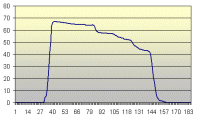 |
38-240 casing, Malt Extract/Dextrose propellant. Replication of 2-24-07C except that propellant
contains more dry malt extract than dextrose, 3:1 ratio. Propellant is made with 21% malt extract, 7% dextrose, and 14% Karo syrup. Doped with 0.01% (0.2g in whole 170gram batch) red iron oxide, it is a non-continuous burn, "chuffy" under propane-torch flame. 3-3/4 inch long fuse-paper ignitor used, extending full length of propellant grain.
Ignitor is expelled immediately upon ignition, followed by an ignition delay of about 2 seconds, but then by a quick ramp-up to full thrust and nominal burn thereafter. Burn time, pressure, and thrust are similar to KN/sucrose motors of this configuration. |
Video 900K 5 seconds .wmv file |
||||||||||||||||||||||||
| 3-17-07B1 |
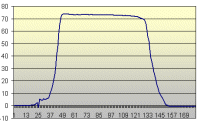
|
38-240 Static test, Fuse Paper/Thermite ignitor.
Grain is uninhibited, very tight fit in case liner so no wrap of
fuse paper around grain this time. Ignitor is strip of rich fuse
paper 1.5 inches wide x 5.5 inches long. Last half of the roll is
spread with 0.2g RIO/Al mixture, 3:1 ratio. Ignitor secured with
full covering of green masking tape. Used new casting base and rod by Bob Gunar, made more precise grain, and the better-centered core may have contributed to the even burn.
Ignition quick, rise to pressure very fast, and thrust "curve" is amazingly flat. This bears replication. |
Video 1 meg 5 seconds .wmv file |
||||||||||||||||||||||||
| 3-17-07B2 |
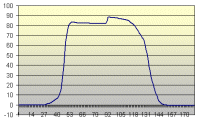
|
38-240 Static test, Fuse Paper/Thermite ignitor. Essentially the same as 3-17-07B1 but with slightly smaller grain.
Similar quick rise to pressure, not quite as clean a curve but quite acceptable. |
Video 1 meg 5 seconds .wmv file |
||||||||||||||||||||||||
| 3-18-07A | 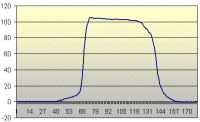 |
38-240 static test, Fuse paper/thermite ignitor, RIO catalyzed propellant. Grain is made from same batch of propellant as used in both 3/17/07 tests, but 0.5% red iron oxide is added.
Burn is somewhat quicker, pressure and peak thrust considerably higher. Peak thrust on this test was about 1450 psi, peaks on the two 3/17 tests were 1000 and 1200 psi. |
Video 1 meg 5 seconds .wmv file |
||||||||||||||||||||||||
| 3-18-07B (click for spreadsheet analysis) |
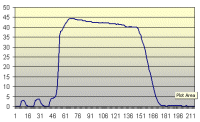 |
38-240 static test, fuse paper/thermite ignitor, Dry Malt Extract propellant.
Grain is made of remnant from 3/9/07C, two parts dry malt extract,
1 part dextrose as primary fuels. This propellant does not
support its own combustion at 1 atmosphere, requires continual flame
source, and even then it chuffs.
Upon ignition, motor started slow burn. After about 6 seconds, it almost extinguished, then started chuffing. The chuffing continued to increase for about 6 seconds after which there was a strong thrust. Apparently the thermite ignitor does not ensure full igniton. Nor is it necessarily to be credited with the fast rise to pressure in the last 3 tests, as this one shows a fast rise once it gets past the chuffing, and by the time that had happened the ignitor was long gone. I'm going to name this propellant "Chuffmaster." |
Video 2 meg 17 seconds .wmv file |
3/25/07D Click for Spreadsheet |
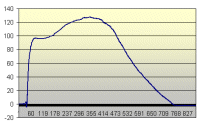 |
Loki 2000 Moonburner, Dextrose Rcandy Propellant made with KNO3, Dextrose and Karo Syrup, just like tradtional rcandy but using dextrose instead of sucrose. Igniter is fuse paper roll with a little CuO/Al thermite.
A little bump on the captured data graph suggests that igniter fired 0.63 seconds before pressure began to rise. Looks like a good flight motor. |
No video, sorry! |
| 18mm Paper-Tube Motors with Packed Dry Propellant 2 parts KNO3, 1 part confectioner's sugar, ground in mortar Core is 1/4th inch diameter, 2-1/4 inches long First rammed in 1/4 tsp Bentonite, then rammed full of propellant in 1/2 tsp increments Top sealed with epoxy. |
|||||||||||||||||||||||||||
| 12-21-07A (click for spreadsheet) |
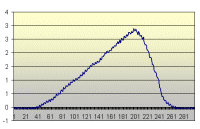 |
12/21/07A
|
12/21/07A Video 800K .wmv file 5 seconds |
||||||||||||||||||||||||
| 12-21-07B |
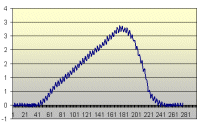 |
12/21/07B
|
12/21/07B Video 700K .wmv file 4 seconds |
||||||||||||||||||||||||
| These little motors are a breeze to make, ignite quickly, and seem to
be fairly consistent and reliable. Their impulse is lower than similar
motors made with rcandy, even when the Kn ratio is the same. Thrust curve is progressive, as expected from this core-burning grain design. |
Flight Video, Mini Saucer 4 meg .wmv file 33 seconds |
12/22/07B Click for Spreadsheet |
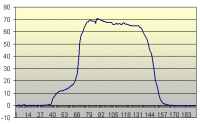 |
38-240 casing,
uninhibited grain propellant test. Standard test motor, to check
propellant made with KNO3 from a new source. The propellant
seemed fine, so I made a grain with it to test.
Funny bump at beginning of burn though to be slow ignition of outer grain. At first, only the core ignited, generating a little thrust, then the outside ignited, generating much more. Good burn, but I wonder why the ISP is low... |
12/22/07B Video 1 meg .wmv file 7 seconds |
| |
38-240 Casing, Tests of grains coated with Polyurethane Varnish. Propellant is normal Rcandy, burn rate 10 seconds per inch at 1 atm. Uninhibited grains were dipped in Minwax Helmsman polyurethane spar varnish the night before and hung out to dry. Next day, grains were easy to handle, not sticky even after being out all humid night. |
||||||||||||||||||||||||||
| 12-24-07A (click for spreadsheet) |
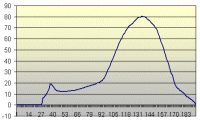 |
12/24/07A
|
12/24/07A Video 800K .wmv file 5 seconds |
||||||||||||||||||||||||
| 12-24-07B |
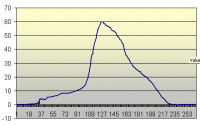 |
12/21/07B
|
12/24/07B Video 700K .wmv file 4 seconds |
||||||||||||||||||||||||
| Slow ramp-up to full pressure was expected. It is thought that the
"shelf" before the peak is the core burning, as it took a bit of time
for the flame to work its way to the outside of the uninhibited grain. First one was a bear to ignite. Fuse paper igniter failed. Fuse paper with Ti failed. Fuse paper with a section of strobe match failed. So I dumped a few short pieces of strobe match down the core and added another fuse paper igniter. That worked. Second one, I dumped small pieces of rcandy down into the core, then inserted a fuse paper igniter. That worked too, after spewing chunks of burning propellant all over the ground. The polyurethane coating is promising, but needs some work. |
|||||||||||||||||||||||||||